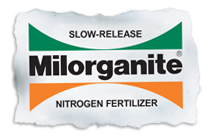Should I Use An Irrigation System?
- Milorganite AgronomistJuly 26, 2025
Irrigation systems, no matter how simple or complex, accomplish one thing: they deliver water to areas of your property that need water. They should also conserve water. Your current “system” may be a hose and sprinkler head or an oscillating sprinkler, and that may be all you need.
Choosing an irrigation system is based on your expectations of what you want it to accomplish. You may find that what you’re currently doing works just fine and you don’t need an irrigation system at all. Most irrigation systems can conserve water when installed and used correctly, especially compared to surface watering.
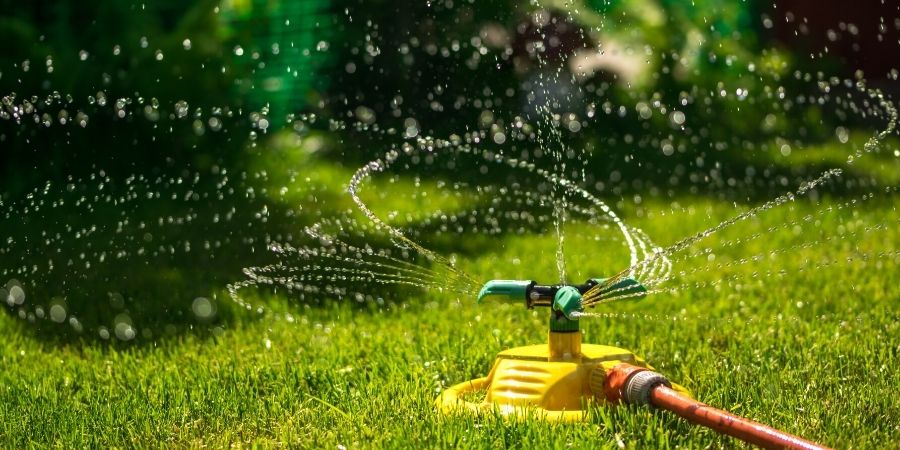
Oscillating sprinkler
The terms “irrigation system” and “sprinkler system” are sometimes used interchangeably, but there’s a difference. A sprinkler can be something like an oscillating sprinkler you attach to a hose, or it can describe part of an integrated, automated irrigation system.
No matter what system you choose, the amount of water a lawn and landscape require remains the same. Established lawns and landscapes require 1 inch of water in a seven-day period, either from rainfall or irrigation. Mulch is always recommended for landscaping beds to help reduce evaporation and regulate soil temperature. Always familiarize yourself with community ordinances regarding watering restrictions.
Considerations When Choosing a System
If you’re not certain if you need an irrigation system, here are some considerations to keep in mind.
- What do you want to accomplish with an irrigation system?
- The size of your property.
- Areas of your property you want to irrigate. Lawn? Trees and shrubs? Landscape beds? Planters? Vegetable garden? Everything?
- Your budget.
- The amount of time and effort you’re willing to invest. DIY or professionally installed.
Let Sleeping Lawns Lie: Seasonal and Drought-induced Dormancy
One significant consideration when choosing an irrigation system, if one is even necessary, is your comfort level in allowing your lawn to go dormant.
Lawns go through natural dormancy during their off-season and will not harm turf. It’s still alive, just not actively growing. Cooler temperatures can cause both cool- and warm-weather grasses to go dormant.

An irrigation system can keep your turf green and growing even in its off-season. But it will likely be its only water source since there isn’t much, if any, rain as the turf’s primary water source. My preference is to allow my turf to go dormant during the winter. It conserves water, which is a cost savings, and it's less work.
In drought conditions, turf can be safely allowed to go dormant, but may still require some irrigation, depending on the duration. Depending on how hot it is, turf can survive a few weeks without water. However, if drought conditions persist, it will require approximately ½ inch of water every 3-4 weeks. It’s not enough water to green up your lawn, but it’s enough to keep it alive until rain returns. Infrequent, deep watering throughout the growing season will encourage strong, deep root systems, which makes it more drought-tolerant.
Installing a complete irrigation system may not be an economical choice if you only intend to use it during drought conditions. Surface irrigation utilizing a hose and sprinkler head may be all you need.
Types of Irrigation Systems, Optimal Use
The following are descriptions of various standard residential irrigation methods and systems, ranging from manually watering with a hose or simple DIY systems that connect to a faucet, to automated, professionally installed systems. You can mix and match irrigation methods and systems to achieve your desired results.
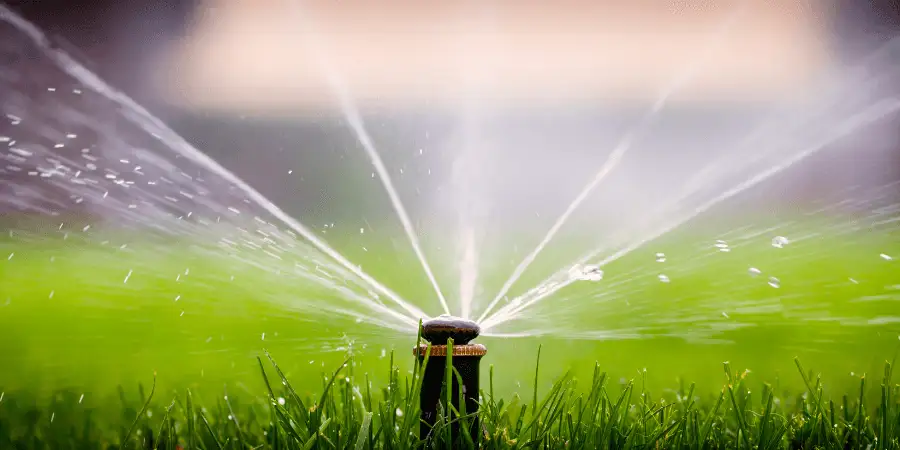
Automated systems and some DIY systems include controllers so you can schedule watering times and durations. This helps reduce evaporation by watering early in the morning, prevents the spread of plant diseases, especially fungus, and ensures the proper amount of water is applied.
Be mindful of conserving water. No matter what method you choose to irrigate your property, I recommend adding a rain sensor or soil moisture sensor, depending on the type of system you choose. If it detects rain, the system will modify its watering schedule accordingly.
Surface Irrigation (most common)
Surface irrigation, or surface watering, is the most common type of irrigation. Like rain, water is applied from above and allowed to soak into the soil. Watering by hand using a hose and sprinkler head is the most straightforward watering method, aside from using a watering can.
There are many “hose-end” sprinklers to choose from, including hand-held, as well as oscillating and rotary types. A watering wand can help get water at the root level rather than from overhead. Oscillating sprinklers can be used to cover larger areas. Some impact sprinklers can be adjusted to reach up to 45 feet. There are also sprinkler heads that can be adjusted to water in specific patterns for oddly shaped areas of your property.
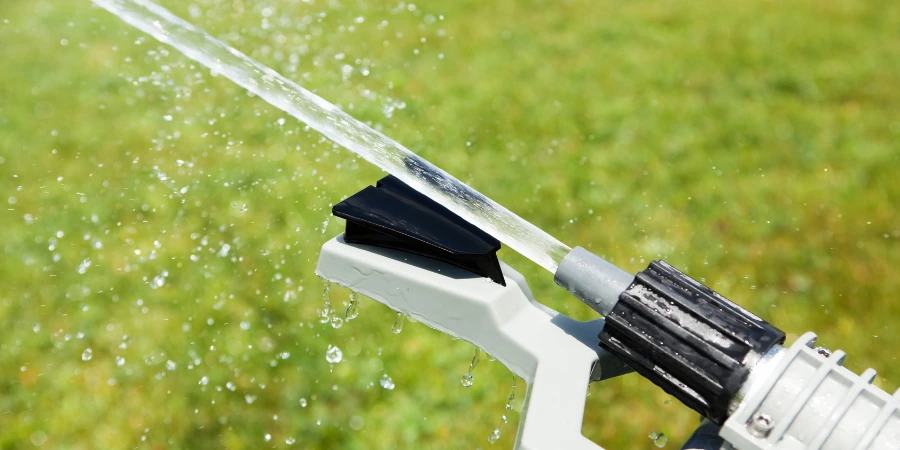
Impact Sprinkler
Surface irrigation can be hit-and-miss with regard to the amount of water applied and how evenly it’s applied, making it difficult to know if everything has been watered adequately. When watering an area equally, some plants may receive too much water, while others may not get enough, depending on their moisture needs. Use several rain gauges throughout your yard to help monitor how much water has been applied.
There are downsides to surface watering. There are limitations on how far a hose can reach, possibly missing difficult-to-reach areas. Using a hose may be too heavy or awkward for some. Evaporation can be problematic, as water on the surface evaporates more quickly.
If the water flow rate is too high, the water doesn’t have time to soak into the soil and instead runs off. This can be particularly problematic on slopes and clay, sandy or compacted soil. You can manually decrease the water pressure to more closely match the soil’s ability to absorb it, but watering will take longer.
Surface watering can sometimes spread plant diseases. Water splashed up from the soil can distribute pathogens, such as fungus, from the soil to the plant. Mulching can help hamper this, as does watering early in the morning to allow plants to dry throughout the day.
When done thoughtfully, surface irrigation will work well for smaller yards and budgets. It’s cost-effective but requires time and labor. Using a variety of sprinkler heads, you can likely water your entire yard.
Drip Irrigation
Drip irrigation is a system using tubing and emitters for any non-grass areas and is one of the most water-saving, efficient irrigation systems available. Standard sprinklers are rated in gallons per minute. Drip irrigation systems are rated in gallons per hour. The slow flow rate allows time for water to seep into the soil, reducing the chance of runoff.
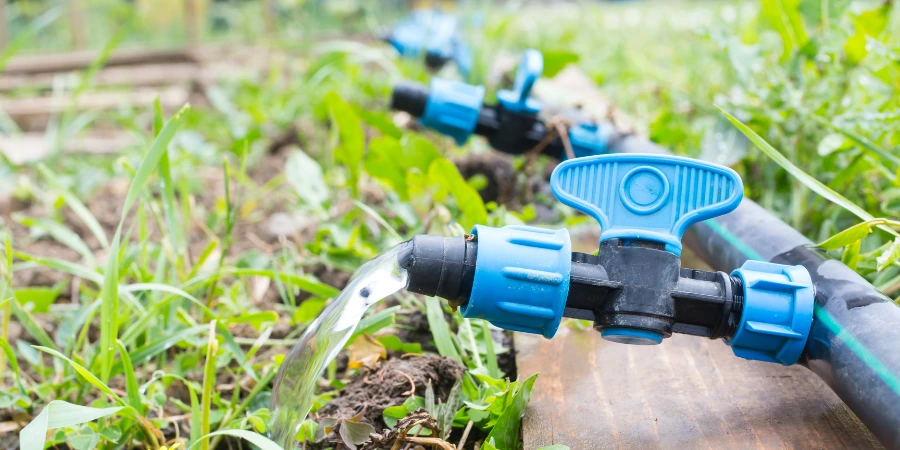
Drip irrigation
Drip irrigation provides precise, spot irrigation at root level for trees, shrubs, landscaping beds, vegetable gardens and planters. The system is attached to a faucet and, with the addition of a timer, can be automated. It can be a stand-alone irrigation system or part of a fully automated system.
There are many types of emitters available. You can select emitters to regulate water flow rates depending on watering needs. Even adjacent plants with different moisture requirements can be watered using emitters with different flow rates.
Emitters are attached to the tubing by using a tool to puncture the tubing to customize it for your needs. Plugs can be used when an emitter is removed. To help protect it from sun damage, cover the tubing with a couple of inches of mulch, but don’t bury it in the soil. Drip irrigation tubing is longer-lasting than soaker hoses. Installing a drip irrigation system is a straightforward DIY project, as no trenching is required.
Automatic Irrigation System
An automatic irrigation system uses a number of components to accomplish various watering needs throughout your yard and landscape. The system is controlled by a timer that is programmed to automatically control the watering time for each irrigation zone. In-ground irrigation systems can be winterized in colder climates where a deep freeze may damage the system.
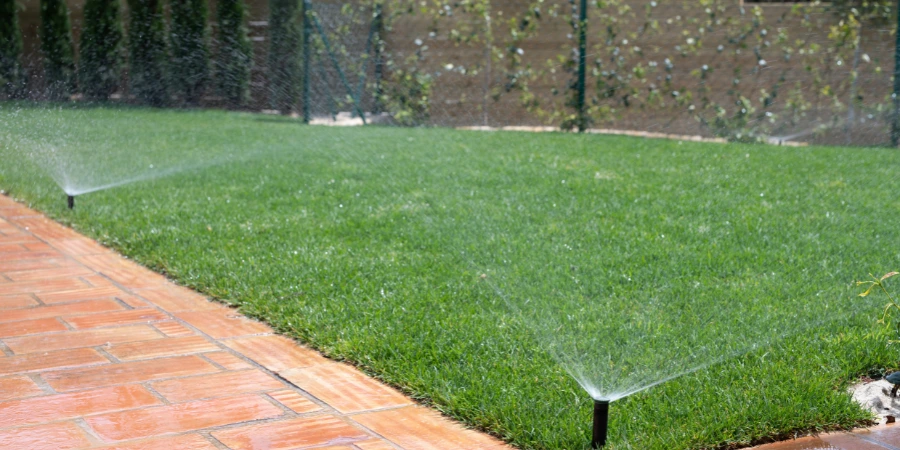
Automatic Irrigation
An automatic system can be installed by a professional, or it can be an involved DIY project. First, you’ll need a design plan to identify different zones throughout your property. Based on this, you’ll be able to select the components that will work best for that zone.
Some of the components that may be included in an automatic irrigation system include:
- Fixed-spray sprinklers are used to water small to medium-sized and irregularly shaped areas. They can be customized using nozzles with different spray patterns.
- Rotary sprinklers provide a single stream or multiple streams of water while rotating and can cover medium-sized areas around 20–25 feet. They offer more control of the water flow rate compared to a fixed spray head. A slower flow rate allows water to soak into the soil, which reduces runoff. They’re good for sloped areas and for compacted soil, such as clay.
- Single-stream rotary sprinklers can cover large areas from about 20–50 feet. Different nozzles help you customize the distance and the rate of water being applied.
- Impact rotary sprinklers offer the greatest coverage—25–55 feet. This is the type of sparkler that makes the rhythmic “ch-ch-ch-ch” sound. It takes about two and a half times longer than a spray head to deliver the same amount of water. It’s a good option for slopes or areas that take longer for water to soak in.
- Drip irrigation, as described above, can be added as a component of an automatic irrigation system.
Soaker Hose
You may be interested in an irrigation system that waters only landscaping beds, as well as flower and vegetable gardens. If that’s the case, a soaker hose may be a good, cost-effective option.
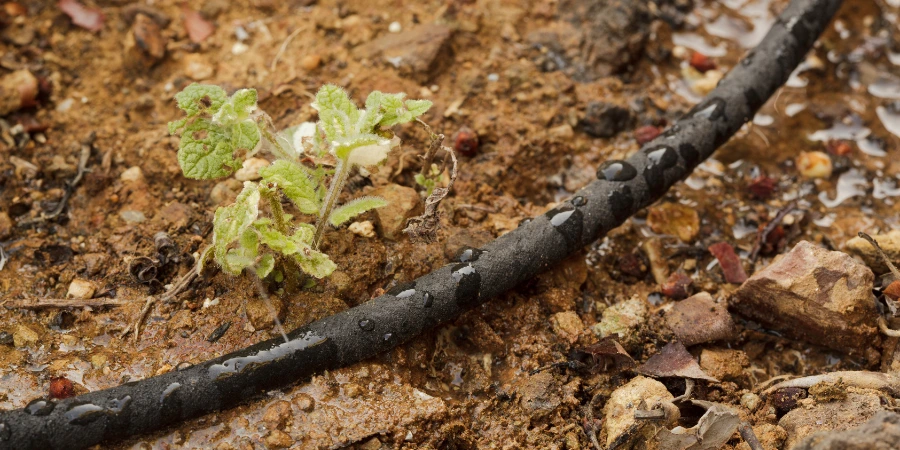
Soaker hose
A soaker hose is made from porous material that allows water to slowly drip into the soil at root level. They’re easy to snake around plants and can be moved if necessary. Soaker hoses shouldn’t be buried, as they can become clogged. Instead, cover the hose with a couple of inches of mulch to help reduce water evaporation and protect the hose from sun damage, while also disguising the hose. They don’t splash water onto leaves, which reduces the chance of fungal diseases compared to surface watering.
Soaker hoses are connected to a faucet and can be automated with the addition of a timer. Flow rate is adjusted at the faucet, but depending on water pressure, less water may reach the end of the hose. They can be difficult to repair if damaged.
Rain Barrels
Rain barrels collect rainwater from downspouts for future use. They’re a good option for hand watering smaller, nearby areas such as planters, and small vegetable gardens, as well as specific landscape beds, trees, and shrubs. Rain barrels aren’t a good option if you’re looking to water your lawn.
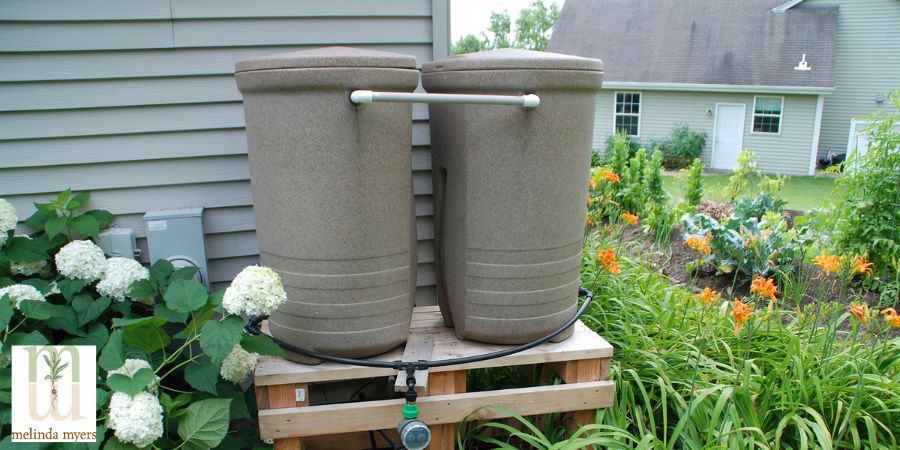
You can attach a hose to a rain barrel to direct water short distances to where you’d like. Raising the rain barrel on cinderblocks or another platform will increase the water pressure, which can extend the distance you can water using a hose. Rain barrel overflow can be diverted into a rain garden.
As you consider the different watering methods and systems available, keep water conservation in mind. How can you maintain a healthy lawn, landscape and gardens using the least amount of water necessary? The Milwaukee Metropolitan Sewerage District (MMSD ) is in the clean-water business and Milorganite is the result of that process .

